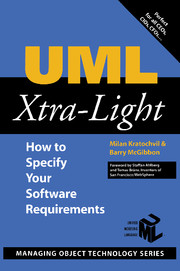Book contents
- Frontmatter
- Contents
- Foreword
- Preface
- Acknowledgments
- About the Authors
- How to Customize This Book
- Chapter 1 Introduction
- Chapter 2 Aligning to the Business
- Chapter 3 Adding Rigor to the Requirements
- Chapter 4 Sketching the Inside Structure
- Chapter 5 Sketching the Inside Dynamics
- Chapter 6 Moving Toward Components
- Chapter 7 Mapping from Classes to Data Models
- Chapter 8 Concluding Remarks
- Some Suggested Readings
- Index
Chapter 8 - Concluding Remarks
Published online by Cambridge University Press: 14 October 2009
- Frontmatter
- Contents
- Foreword
- Preface
- Acknowledgments
- About the Authors
- How to Customize This Book
- Chapter 1 Introduction
- Chapter 2 Aligning to the Business
- Chapter 3 Adding Rigor to the Requirements
- Chapter 4 Sketching the Inside Structure
- Chapter 5 Sketching the Inside Dynamics
- Chapter 6 Moving Toward Components
- Chapter 7 Mapping from Classes to Data Models
- Chapter 8 Concluding Remarks
- Some Suggested Readings
- Index
Summary
Think Big, Start Small, and Sustain the Effort
Most people agree that analysis occurs only when the domain expert is in the room. In our experience, in addition to being present, experts are also supposed to understand the language “spoken” in the room. The language problem has often turned out to be even bigger than that of business-travel logistics. The UML, however, provides many powerful tools to make yourself understood in the room, which come in handy for the frequent visitor. By writing this book, we simply seized the opportunity and packaged much of the substance in a lightweight manner for this purpose.
Implementing UML models (and tools) to specify requirements doesn't take much time. Employing them in a practical approach preshrunk to fit your type of systems takes more training days and practical experience. Finally, adopting a component approach throughout the enterprise can take years of sustained effort, but it's definitely worthwhile.
UML Under Time Constraints
We believe the lightweight style of this book makes it possible for experts from many other areas to approach practical, basic UML. A frequent guest to the landscape of software can view this as a phrase book for the journey, keeping grammar detail at a minimum because many good grammar books already exist for this modeling language.
At the same time, we've provided some hints on cooperation with the hosts and on what parts of the language a guest typically becomes involved with in practice.
- Type
- Chapter
- Information
- UML Xtra-LightHow to Specify Your Software Requirements, pp. 97 - 100Publisher: Cambridge University PressPrint publication year: 2002



